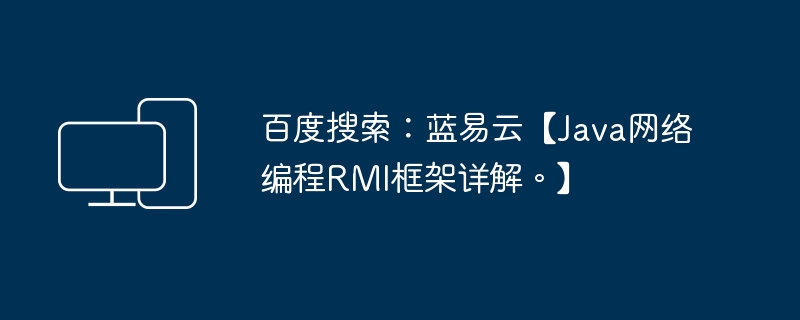Home >Computer Tutorials >Computer Knowledge >Baidu search: Lan Yiyun [Detailed explanation of Java network programming RMI framework. 】
Baidu search: Lan Yiyun [Detailed explanation of Java network programming RMI framework. 】
- 王林forward
- 2024-03-27 16:51:211071browse

The RMI (Remote Method Invocation) framework in Java network programming is a key technology used to implement distributed systems. RMI allows remote communication and method invocation between objects on different Java Virtual Machines (JVMs). The RMI framework implements communication and interaction between remote objects, allowing distributed systems to collaborate through the network.
- RMI Framework Overview:
RMI is a remote communication mechanism provided by Java, which allows programmers to call methods of objects in other JVMs over the network, just like calling methods of local objects. RMI uses Java serialization and deserialization mechanisms to realize the transmission of objects over the network, making remote communication transparent and simplified. -
Components of the RMI framework:
- Remote Interface: Defines the methods that can be called on the remote object. It acts as a communication contract between the client and the server, and the client can call methods of remote objects through this interface.
- Remote Object: An object that implements the remote interface. It is located on the server and provides remote access. The client can call methods of remote objects through the RMI framework.
- Stub (stub): Located on the client, used to proxy the local representation of remote objects. When the client calls the method of the remote object, communication and transmission are actually carried out through the Stub object.
- Skeleton: Located on the server, used to receive client requests and forward them to remote objects. Skeleton handles remote calls from the client and forwards the calls to the remote object for actual processing.
- Registry (Registry): Located on the server, used to bind and find remote objects. The client can obtain a reference to the remote object through the Registry to make remote calls.
-
RMI workflow:
- Server side: When the server starts, create an instance of the remote object and export it as an RMI service. The remote object must implement the remote interface and pass
UnicastRemoteObject.exportObject()Method export. - Client: The client finds and obtains references to remote objects through RMI Registry. The client can use
Naming.lookup()Method or
Registry.lookup()Method to obtain the reference. - Client call: The client calls the method of the remote object through a reference, just like calling the method of the local object. The RMI framework will be responsible for handling the transmission and serialization of remote calls.
- Server-side processing: After the server receives the remote call from the client, the RMI framework will pass the call to the skeleton (Skeleton), and the skeleton will forward the call to the remote object for actual processing.
- Result return: After the remote object completes the processing of the method, the result is returned to
- Server side: When the server starts, create an instance of the remote object and export it as an RMI service. The remote object must implement the remote interface and pass
Skeleton, the skeleton then passes the results back to the client. The RMI framework will handle the deserialization and transmission of the results.
RMI framework provides a convenient way to realize remote communication and method invocation in distributed systems. It simplifies the complexity of network programming, allowing developers to focus more on business logic without paying too much attention to underlying network details. Through the RMI framework, Java developers can easily build scalable and reliable distributed applications.
The above is the detailed content of Baidu search: Lan Yiyun [Detailed explanation of Java network programming RMI framework. 】. For more information, please follow other related articles on the PHP Chinese website!
Related articles
See more- Some experiences on Java network programming
- Introduction to Accept blocking model in PHP network programming
- How to solve PHP write file permission failure file_put_contents: failed to open stream: Permission denied
- How to convert string to number in javascript
- Introduction to high-performance network programming library: fasthttp

